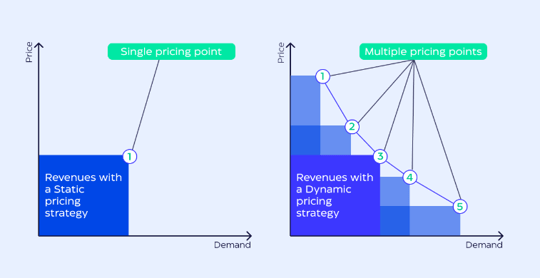What is dynamic pricing?
Dynamic pricing, also referred to as surge pricing or time-based costing, is a strategic approach utilized by businesses to gauge prevailing market demands and establish flexible pricing structures for their offerings. Essentially, it operates as a form of pricing differentiation.
To determine the most suitable pricing approach for your products or services, it's crucial to consider various factors such as customer purchasing tendencies, supply and demand dynamics, competitor pricing strategies, and external market influences.
Dynamic pricing has evolved into an ubiquitous strategy across various sectors, driven by the surge of e-commerce platofrms like Amazon. It is employed in public transportation, electricity, retail, entertainment, leisure, and hospitality industries. This approach is fueled by the need to adapt pricing in response to demand fluctuations and market dynamics, ensuring competitiveness and maximizing revenue potential.

The focus here lies on dynamic pricing customized particularly for online businesses, which have witnessed significant expansion in recent years, particularly in the B2B realm. Leveraging the digital landscape, merchants can promptly adapt their pricing strategies to respond to demand fluctuations, thereby gaining a competitive edge. This approach not only benefits B2C transactions but also fosters advantageous relationships in B2B interactions, enabling businesses to optimize pricing strategies based on real-time market conditions. Additionally, dynamic pricing in online environments offers distinct advantages such as enhanced flexibility, improved inventory management, and the ability to target specific customer segments more effectively, ultimately contributing to increased profitability and customer satisfaction.
What are the benefits of dynamic pricing?
source: flipkart Commerce Cloud
Understanding dynamic pricing and its benefits is essential for Original Equipment Manufacturers (OEMs) operating in the spare parts market. Here's why dynamic pricing can significantly benefit your business:
- Dynamic Pricing Enhances Control Over Your Pricing Strategy:
Dynamic pricing grants greater control over your pricing strategy. By leveraging real-time data on price trends across your industry, including insights into competitors' pricing fluctuations and supply-and-demand dynamics, you gain the ability to set optimal prices for your spare parts. This strategic approach empowers you to maximize revenue while staying competitive.
- Dynamic Pricing Enables Flexibility Without Compromising Brand Value
Dynamic pricing offers flexibility without undermining your brand's value. By establishing a price floor that reflects your brand's integrity, you can adapt to market changes while maintaining profitability.
- Dynamic Pricing Boosts Your Overall Margin
If your competitors offer a part that you sell at a higher price, you can use this knowledge and this strategy to maximize your profit margin.
- Effective Management with Specialized Dynamic Pricing Software
Managing dynamic pricing effectively requires sophisticated software capable of monitoring market trends and competitor activities. While this task may seem daunting, leading e-commerce platforms and dynamic pricing software offer automated tools that simplify the process, such as MARKT-PILOT's PRICEGUIDE solution, offering tailored dynamic pricing recommendations. By leveraging such software, OEMs can access accurate data and make informed pricing decisions, driving sustainable growth in the spare parts market.

Common Questions Surrounding Dynamic Pricing
Why is dynamic pricing important?
-
For OEMs in the spare parts market, dynamic pricing emerges as a vital tool to maintain competitiveness. Utilizing price optimization software enables real-time tracking of competitors, facilitating trend analysis and informed pricing decisions.
-
Dynamic pricing empowers OEMs with enhanced control over pricing dynamics. Instead of passively observing pricing effectiveness, the ability to swiftly adjust prices within minutes offers a proactive approach. By leveraging data-driven insights, OEMs can implement intuitive price changes promptly, resulting in potential cost savings and improved revenue management.
What is an example of dynamic pricing?
There are multiple dynamic pricing methods. These are a few examples of how companies can change their prices flexibly:
-
Demand-based pricing: Manufacturers can adjust spare parts prices based on demand fluctuations. For example, suppose there's a sudden increase in demand for a particular spare part due to equipment failures or seasonal trends. In that case, the manufacturer can raise the price to capitalize on this demand.
-
Segmented dynamic pricing: OEMs can implement dynamic pricing based on customer segmentation. For example, they may offer different prices to different customer segments based on factors such as volume of purchase, customer loyalty, or geographic location.
Should you tell customers about your dynamic pricing?
Dynamic pricing stands as a powerful tool for manufacturers, particularly OEMs in the spare parts market, seeking to strike the delicate balance between maximizing profits and staying competitive. By harnessing real-time data and sophisticated software solutions, businesses can not only adapt to market fluctuations but also enhance control over their pricing strategies, foster brand integrity, and achieve long-term cost savings. Understanding the nuances of dynamic pricing and implementing it effectively can propel companies toward sustained growth and success in today's dynamic business landscape. As technology continues to advance and consumer behaviors evolve, the role of dynamic pricing will likely become even more pivotal, offering manufacturers a strategic edge in navigating the complexities of the market.
With our PRICEGUIDE solution for OEMs and machine manufacturers, this access to data and intelligence enables dynamic pricing for your spare parts.
Check out MARKT-PILOT's dynamic pricing software solution today.
